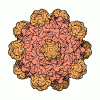+ Open data
Open data
- Basic information
Basic information
| Entry | Database: PDB / ID: 6bwx | |||||||||||||||||||||
|---|---|---|---|---|---|---|---|---|---|---|---|---|---|---|---|---|---|---|---|---|---|---|
| Title | Atomic resolution structure of human bufavirus 1 | |||||||||||||||||||||
 Components Components | VP2 | |||||||||||||||||||||
 Keywords Keywords | VIRUS LIKE PARTICLE / parvovirus / protoparvovirus | |||||||||||||||||||||
| Function / homology | Parvovirus coat protein VP2 / Parvovirus coat protein VP1/VP2 / Parvovirus coat protein VP1/VP2 / Capsid/spike protein, ssDNA virus / T=1 icosahedral viral capsid / structural molecule activity / VP2 Function and homology information Function and homology information | |||||||||||||||||||||
| Biological species |  Bufavirus-1 Bufavirus-1 | |||||||||||||||||||||
| Method | ELECTRON MICROSCOPY / single particle reconstruction / cryo EM / Resolution: 2.84 Å | |||||||||||||||||||||
 Authors Authors | Mietzsch, M. / Agbandje-McKenna, M. | |||||||||||||||||||||
 Citation Citation |  Journal: Viruses / Year: 2018 Journal: Viruses / Year: 2018Title: Atomic Resolution Structures of Human Bufaviruses Determined by Cryo-Electron Microscopy. Authors: Maria Ilyas / Mario Mietzsch / Shweta Kailasan / Elina Väisänen / Mengxiao Luo / Paul Chipman / J Kennon Smith / Justin Kurian / Duncan Sousa / Robert McKenna / Maria Söderlund-Venermo / ...Authors: Maria Ilyas / Mario Mietzsch / Shweta Kailasan / Elina Väisänen / Mengxiao Luo / Paul Chipman / J Kennon Smith / Justin Kurian / Duncan Sousa / Robert McKenna / Maria Söderlund-Venermo / Mavis Agbandje-McKenna /   Abstract: Bufavirus strain 1 (BuV1), a member of the genus of the , was first isolated from fecal samples of children with acute diarrhea in Burkina Faso. Since this initial discovery, BuVs have been isolated ...Bufavirus strain 1 (BuV1), a member of the genus of the , was first isolated from fecal samples of children with acute diarrhea in Burkina Faso. Since this initial discovery, BuVs have been isolated in several countries, including Finland, the Netherlands, and Bhutan, in pediatric patients exhibiting similar symptoms. Towards their characterization, the structures of virus-like particles of BuV1, BuV2, and BuV3, the current known genotypes, have been determined by cryo-electron microscopy and image reconstruction to 2.84, 3.79, and 3.25 Å, respectively. The BuVs, 65-73% identical in amino acid sequence, conserve the major viral protein, VP2, structure and general capsid surface features of parvoviruses. These include a core β-barrel (βB-βI), α-helix A, and large surface loops inserted between these elements in VP2. The capsid contains depressions at the icosahedral 2-fold and around the 5-fold axes, and has three separated protrusions surrounding the 3-fold axes. Structure comparison among the BuVs and to available parvovirus structures revealed capsid surface variations and capsid 3-fold protrusions that depart from the single pinwheel arrangement of the animal protoparvoviruses. These structures provide a platform to begin the molecular characterization of these potentially pathogenic viruses. | |||||||||||||||||||||
| History |
|
- Structure visualization
Structure visualization
| Movie |
 Movie viewer Movie viewer |
|---|---|
| Structure viewer | Molecule:  Molmil Molmil Jmol/JSmol Jmol/JSmol |
- Downloads & links
Downloads & links
- Download
Download
| PDBx/mmCIF format |  6bwx.cif.gz 6bwx.cif.gz | 5.4 MB | Display |  PDBx/mmCIF format PDBx/mmCIF format |
|---|---|---|---|---|
| PDB format |  pdb6bwx.ent.gz pdb6bwx.ent.gz | Display |  PDB format PDB format | |
| PDBx/mmJSON format |  6bwx.json.gz 6bwx.json.gz | Tree view |  PDBx/mmJSON format PDBx/mmJSON format | |
| Others |  Other downloads Other downloads |
-Validation report
| Summary document |  6bwx_validation.pdf.gz 6bwx_validation.pdf.gz | 1.6 MB | Display |  wwPDB validaton report wwPDB validaton report |
|---|---|---|---|---|
| Full document |  6bwx_full_validation.pdf.gz 6bwx_full_validation.pdf.gz | 2.4 MB | Display | |
| Data in XML |  6bwx_validation.xml.gz 6bwx_validation.xml.gz | 912.9 KB | Display | |
| Data in CIF |  6bwx_validation.cif.gz 6bwx_validation.cif.gz | 1.3 MB | Display | |
| Arichive directory |  https://data.pdbj.org/pub/pdb/validation_reports/bw/6bwx https://data.pdbj.org/pub/pdb/validation_reports/bw/6bwx ftp://data.pdbj.org/pub/pdb/validation_reports/bw/6bwx ftp://data.pdbj.org/pub/pdb/validation_reports/bw/6bwx | HTTPS FTP |
-Related structure data
| Related structure data |  7300MC  7301C  7302C  6bx0C  6bx1C M: map data used to model this data C: citing same article ( |
|---|---|
| Similar structure data |
- Links
Links
- Assembly
Assembly
| Deposited unit | 
|
|---|---|
| 1 |
|
- Components
Components
| #1: Protein | Mass: 61567.953 Da / Num. of mol.: 60 Source method: isolated from a genetically manipulated source Source: (gene. exp.)  Bufavirus-1 / Gene: BF-003 / Production host: Bufavirus-1 / Gene: BF-003 / Production host:  Has protein modification | N | |
|---|
-Experimental details
-Experiment
| Experiment | Method: ELECTRON MICROSCOPY |
|---|---|
| EM experiment | Aggregation state: PARTICLE / 3D reconstruction method: single particle reconstruction |
- Sample preparation
Sample preparation
| Component | Name: Bufavirus-1 / Type: VIRUS / Entity ID: all / Source: RECOMBINANT |
|---|---|
| Molecular weight | Value: 4 MDa / Experimental value: NO |
| Source (natural) | Organism:  Bufavirus-1 Bufavirus-1 |
| Source (recombinant) | Organism:  |
| Details of virus | Empty: YES / Enveloped: NO / Isolate: SEROTYPE / Type: VIRUS-LIKE PARTICLE |
| Natural host | Organism: Homo sapiens |
| Virus shell | Name: BuV1 capsid |
| Buffer solution | pH: 7.4 |
| Specimen | Embedding applied: NO / Shadowing applied: NO / Staining applied: NO / Vitrification applied: YES |
| Vitrification | Cryogen name: ETHANE |
- Electron microscopy imaging
Electron microscopy imaging
| Experimental equipment |  Model: Titan Krios / Image courtesy: FEI Company |
|---|---|
| Microscopy | Model: FEI TITAN KRIOS |
| Electron gun | Electron source:  FIELD EMISSION GUN / Accelerating voltage: 300 kV / Illumination mode: FLOOD BEAM FIELD EMISSION GUN / Accelerating voltage: 300 kV / Illumination mode: FLOOD BEAM |
| Electron lens | Mode: BRIGHT FIELD / Cs: 2.7 mm |
| Image recording | Electron dose: 60 e/Å2 / Film or detector model: GATAN K2 SUMMIT (4k x 4k) / Num. of real images: 1961 |
| Image scans | Movie frames/image: 60 / Used frames/image: 3-30 |
- Processing
Processing
| Software | Name: PHENIX / Version: 1.10-2155_2155: / Classification: refinement | ||||||||||||||||||||||||||||||||||||||||
|---|---|---|---|---|---|---|---|---|---|---|---|---|---|---|---|---|---|---|---|---|---|---|---|---|---|---|---|---|---|---|---|---|---|---|---|---|---|---|---|---|---|
| EM software |
| ||||||||||||||||||||||||||||||||||||||||
| CTF correction | Type: PHASE FLIPPING AND AMPLITUDE CORRECTION | ||||||||||||||||||||||||||||||||||||||||
| Particle selection | Num. of particles selected: 59170 | ||||||||||||||||||||||||||||||||||||||||
| 3D reconstruction | Resolution: 2.84 Å / Resolution method: FSC 0.143 CUT-OFF / Num. of particles: 29596 / Symmetry type: POINT | ||||||||||||||||||||||||||||||||||||||||
| Atomic model building | Protocol: RIGID BODY FIT / Target criteria: Correlation coefficient | ||||||||||||||||||||||||||||||||||||||||
| Refine LS restraints |
|
 Movie
Movie Controller
Controller





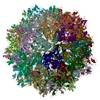


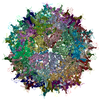
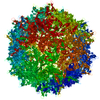
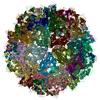


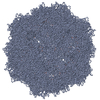
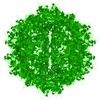
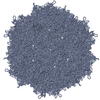
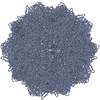
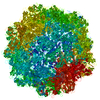

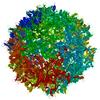
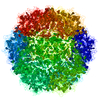


 PDBj
PDBj
